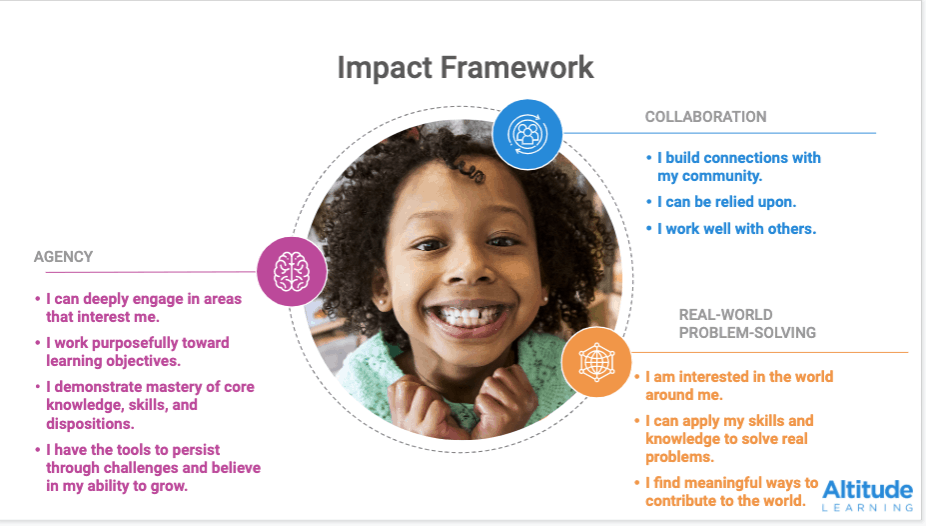Supporting District Change Through Learner-Centered Leadership

By: Devin Vodicka & Tom Vander Ark
The job of a school superintendent is challenging enough in normal times. The COVID-19 pandemic has added new and unprecedented complexity. Moving Forward Together is a groundbreaking coalition of leading organizations in education innovation. Led by two former superintendents, Devin Vodicka and Tom Vander Ark, the coalition has come together to help district leaders quickly put in place the new system required by this moment. Here, we share perspective on where to start, what steps to consider, and how we can help.
Where to Start
As Superintendents, we all understand the compliance requirements that surround us. Sometimes this web of policies, rules, and requirements is a frustrating hindrance to the change we want to deliver for our communities. Other times it can be a catalyst. In any case, it provides guidance and establishes the boundaries in which we live our day-to-day.
What happens when it suddenly falls away? When no one is telling us clearly what to do? When some of the requirements that have seemed as certain as the sunrise (like state tests) suddenly aren’t requirements anymore?
In times like this, it is more critical than ever that we lead with our values, are clear and transparent about the outcomes we are working to achieve, and that we use these values and outcomes to make decisions, and create the conditions in which our teams can succeed.
Lead With Your Values
In times of change, it is critical that we have a philosophical underpinning guiding our decisions. Without it, our leadership will feel haphazard and we will be tempted to change directions with each new development. This philosophy should be transparent, and specific enough that it can offer some clarity to those around us about what decisions are being based on, and why. Ideally, it is so clear, that it enables others to make decisions based on it too. For us, this philosophy is learner-centered education. We believe this vision for the future of school and learning can be the source of this strong set of guiding principles that, if established clearly, can unblock decisions for you, and, as importantly, for others within your system.
Define the Outcomes
When time is of the essence, a lack of clarity about the outcomes that you are trying to achieve is the quickest path to frustration and confusion. Without it, each decision will feel disconnected from the next, resulting in inefficiency, the inability of groups and leaders to move forward without your permission, and an ultimate lack of ownership by those in the system who are most important to ultimately getting things done. We believe the best place to define these outcomes is in a learner profile that makes it clear to everyone, what the system is trying to accomplish, and why.
Create the Conditions
For educators to create a learner-centered experience, leadership has to create an educator-centered system around them. This means that educators must have agency and be empowered to make decisions. But for this to work, they have to internalize the outcomes and values of the system. By aligning system leaders and teams on this shared understanding and providing them space to make decisions, you will enable teams to move quickly and effectively in stressful and uncertain circumstances. You will be better positioned to reap the benefits of distributed leadership, having established the foundation for a learner-centered, values-based, and agile culture.
Steps to Consider
Clarify Your Learner-Centered Philosophy
It may seem crazy in this moment to try to step back and return all the way to your point of origin. But it is absolutely worth it and will unblock so many other elements of the change process. To accelerate this, we recommend drawing from the principles and vision for learner-centered leadership. Learner-centered leadership frames all system decisions with students as the focal point. A learner-centered system values student agency and seeks to create authentic, open-walled learning experiences. Conveying this vision clearly to your teams will help them visualize the road ahead and guide their decision-making as they will need to move quickly as context changes.
Create and Elevate Your Learner Profile
Developing a learner profile or “Impact Framework” will orient your teams and community in the perspectives of your students, and provide educators with a refreshed and clear vision about what matters most. Additionally, it will better align the outcomes your system is seeking to achieve with the actual skills, dispositions, and habits students need for success in the modern world. The ideal framework combines the traditional outcomes and measures we are familiar with, with a new, broader vision for success. Importantly, it incorporates traditional metrics under the high level, essential outcomes we are ultimately striving for: outcomes like collaboration, agency, and real-world problem-solving.
See Opportunities Emerge
Once you have these foundational ingredients in place, you may be surprised to see how quickly opportunities emerge. Your team will notice places that seemed liked roadblocks are now prospective innovations. For example, utilizing a framework like the one below, that values finding “meaningful ways to contribute to the world”, significant time spent outside of the traditional classroom setting can suddenly become an asset to be leveraged instead of a roadblock to problem-solve. Suddenly your team can spend time figuring out how to support this time in ways that result in authentic learning aligned to this outcome. The result will likely be a day-to-day experience that looks and feels very different, not only from traditional school but also from our previous attempts at virtual learning. Time and space for learning will expand and pull in students in a way that you did not realize possible. 
Empower Your Team By Focusing Your Energy on Process
As your educators and teams start to identify the opportunities within a learner-centered framework, give them the space to build solutions that work for your community. Support educators and teams to align decisions on the key aspects of your impact framework. Fundamental to this step is shifting your focus from owning content to the owning process. You no longer need to be the decider of the details, instead, you become the facilitator of a process through which others can make decisions quickly aligned to the values and impact framework. This is exactly the kind of shift in power and leadership we want to see in our learner-centered classrooms, and you have the opportunity to model it!
Teams will need the flexibility and freedom to move quickly as reopening plans become more concrete, and the values and impact framework provide a focus. Establishing team habits to recenter conversations on this framework will guarantee student experience remains central even while circumstances may change. Consider where and how your educators may need support in shifting their vision and skills to match with this revised schooling model.
Hold Space for Change and Make Learning Visible
Moving to a learner-centered impact framework doesn’t work if you retreat back to traditional assessment techniques. In this new vision for student success, new approaches are required. Focus efforts on making learning visible. This will happen through competency-based assessment, multimedia evidence, portfolios, and demonstrations of learning.
These forms of assessment are more aligned to the unique conditions we are experiencing today. But that doesn’t mean the change will be easy. Hold the messy space for educators and others within the system to figure it out, and give them space and support to do so.
It is tempting in periods of intense change to grasp for what is familiar. Learner-centered leadership requires resisting this urge and holding the space for change to unfold. It’s one of the hardest parts of effective change leadership.
Believe in the capacity of your educators and learners to rise to the occasion, and trust that if you hold space for people to move through the stages of change a new and better system will be the result on the other side.
How We Can Help
Our team understands the convergence of challenges district leaders are facing. We are ready to stand with you in placing students at the center of your planning and re-opening work. Our organizations have broad and deep experiences to draw from. We are able to provide input and advice, strategy and implementation support, technology, and talent development. We are ready to help you:
- Define your values. We can help you understand the learner-centered vision for the future, connect it with your own personal and your team philosophy of education, and establish the philosophical underpinnings of your strategy that will accelerate your work.
- Build learner profiles. Understanding past experiences, learner ambition, and pain points will get you to a clear learner profile. We can help you gather this insight quickly and share it with your system to ground decisions.
- Identify the opportunities for innovation. Throughout this transition, new spaces and ideas will emerge as possibilities for innovation and practice change. We can help you identify these and support you in building out possible solutions and implementation plans.
- Partner with and empower educators. Educator voice and experience is critical to instructional change. We can help you partner with, make space for, and strategize ways to build educator confidence and excitement for this transition to student-centered leadership.
- Follow through and deliver results. Even with clarity of vision, effective engagement with teams, a process that creates space for others to decide and lead, there will be many unexpected challenges that arise along the way. We can help navigate implementation and facilitate effective problem-solving.
- Make learning visible. Assessment practices will need to evolve to fit with the new system for learning. We can help vision, implement, and support your new approach.
- Get technology right. Technology can be a barrier or an enabler for this kind of shift. Having a platform designed according to learner-centered principles will be a big plus to being able to scale and sustain learner-centered practices. We can provide this technology and assist with its implementation.
About the Moving Forward Together coalition
The Moving Forward coalition formed to create one-stop-shop supporting education leaders as they lead through an incredible period of change, challenge, and uncertainty. The pandemic’s direct impact on education, combined with the way it has exacerbated financial pressures and enrollment challenges are causing significant strain on many district systems.
Moving Forward is committed to applying the best thinking and learning from the field in a way that accounts for compliance-related constraints, provides a convenient, one-stop-shop for leaders, and delivers services at a competitive, all rate while engaging experienced practitioners. Anchoring this coalition are:
Altitude Learning provides learner-centered technology solutions to support competency-based, personalized, and authentic learning both through LEAs and direct to families through Altitude Learning @Home. Leaders in learner-centered technology and practice, Altitude’s staff literally wrote the books on Learner Centered Leadership and Learner Centered Innovation.
Getting Smart is a prolific thought leadership in learning innovation uniquely situated to help LEAs establish your approach to innovating for your state’s context. Getting Smart provides a variety of key implementation supports from program design to communications.
The coalition is led by Devin Vodicka, Chief Impact Officer at Altitude Learning and former CA Superintendent of the Year, and Tom Vander Ark, CEO at Getting Smart, former Superintendent in WA State, and the first Executive Director of Education for the Bill & Melinda Gates Foundation.
Other “Moving Forward Together” partners will be pulled in as needed to bring their unique expertise to bear supporting SEA plans. They include: Digital Promise, NGLC, Education Reimagined, KnowledgeWorks, former superintendents, content and assessment experts, and workforce and higher education experts.
For more, see:
- Supporting Statewide Change Through Virtual Course Access Models
- Supporting Statewide Change Through Microgrants to Families
- Supporting Statewide Change Through New Models for Remote Education
Stay in-the-know with innovations in learning by signing up for the weekly Smart Update.






0 Comments
Leave a Comment
Your email address will not be published. All fields are required.